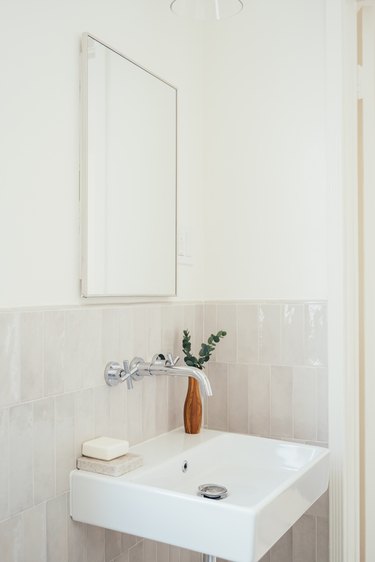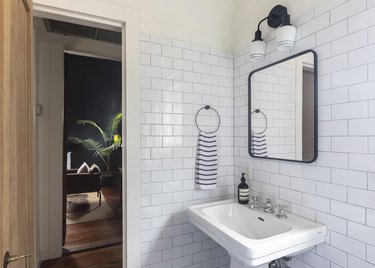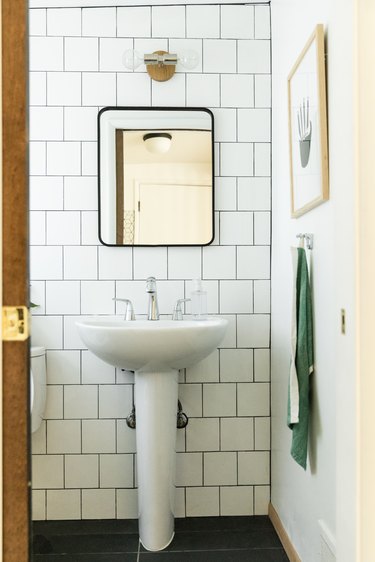Simple and elegant, pedestal bathroom sinks are an excellent choice for small bathrooms. These streamlined sinks can be quite beautiful to behold and feature a small footprint that helps tight spaces feel more open. They sacrifice storage to do so, however, leaving behind the cabinets and drawers of a bathroom vanity. Like all bathroom fixtures, pedestal sinks have both pros and cons you should consider before committing.
The Construction of a Pedestal Sink
Video of the Day
Before choosing a pedestal sink, it's important to understand what it truly is. Yes, it is a sink basin that sits atop a single column, or pedestal. In this case, though, looks are deceiving.
Video of the Day
Many people believe that the pedestal supports the weight of the sink, and it certainly appears to do so. This is incorrect, however. The pedestal is decorative rather than structural, and most of the sink's weight is actually supported by structural lumber within your wall.
If you're doing a full bathroom remodel or feel confident in your DIY ability, a pedestal sink can still make an excellent choice. You may find yourself reconsidering your sink choice, however, if you assumed you could just stand a new pedestal sink in the place where your old vanity was located. This project is a bit more involved than that.
A Pedestal Sink for Every Style
Pedestal bathroom sinks don't have to be stuffy or uptight. Today, you can get a pedestal sink made from an incredibly wide array of different materials including stainless steel, copper, glass and stone. You can also choose a sink made of china or a solid-surface material. Various colors and shapes also abound, allowing you to choose an oval, round or square sink basin.
Note also that most pedestal sinks come in two separate pieces: the sink itself and the pedestal. Because you purchase each piece separately, you have even more freedom to mix and match the styles and components you like.
As with any sink, you can also choose your faucet accommodations. According to Kohler, you can choose a sink with no faucet holes and wall-mount your faucet instead. Some sinks have a single faucet hole for use with a single-handle faucet, while others feature three holes to accept a faucet and two handles. A standard three-hole configuration spreads the holes across a span of 4 inches, while a wide configuration spaces them 8 to 16 inches apart.

The Pros of Pedestal Bathroom Sinks
Pedestal sinks make an excellent choice when you're designing within a small bathroom or powder room. These sinks have a much smaller footprint than vanities and console sinks, making them excellent space savers. The open design also helps create the illusion of more space rather than making you feel boxed in.
You'll also appreciate a pedestal sink on cleaning day. Every part of a pedestal sink is exposed and easy to access, whether you're doing a deep cleaning or a quick wipe down. Unlike vanities that collect dust in and around the toe kick, a pedestal sink offers dust bunnies and spills no place to hide.
Pedestal sinks can also help you minimize bathroom clutter. Vanities have countertops that tend to collect things like razors, hair care products and beauty aids. If this clutter drives you crazy, a pedestal sink can help.
The Cons of Pedestal Bathroom Sinks
A pedestal sink can eliminate bathroom clutter, but it does so by removing storage space. If your bathroom sees a lot of traffic or hosts a large family, you may be wiser to choose a vanity with lots of storage space instead of a pedestal sink. Even if you can live without the extra storage space, a lack of it could turn off potential homebuyers in the future.
Pedestal sinks can also prove to be tricky to install. You must center the drain perfectly under the sink, or the pedestal won't hide it. Depending on the viewing angle, the drain pipe and water supply lines can be visible. Because you and your guests may see some of the plumbing, it's important that you do a nice, clean plumbing job and use P-traps and other pipes that match your other bathroom hardware.
Cost is another potential drawback of pedestal sinks. On average, Fixr reports that as of 2020, the cost to install a pedestal sink is between $325 and $730. A vanity sink, in comparison, costs between $130 and $280 to install. If you buy a vanity sink, however, you'll also need a vanity cabinet. Small single-sink vanities start at about $150 but can be much more expensive. If you're replacing only the sink, a pedestal sink will likely cost more. If you need a whole new vanity, though, removing it in favor of a pedestal sink can sometimes save you money.
Dealing with a Lack of Storage in a Pedestal Sink
If you've moved to a new home with a pedestal sink or switched from a vanity to a pedestal during a remodel, you may struggle to compensate for the lack of storage. Pedestal sinks can make a space seem visibly larger, but you may have underestimated just how much stuff your vanity kept handy. One way to solve the storage problem is to install a medicine chest, a cabinet or shelving on the wall above or next to the sink to provide the storage the sink doesn't offer.
You can also mount toothbrush holders or soap dispensers to the wall above the sink to keep these items handy. If you need room for a soap dispenser, get creative. Try transferring liquid soap into a tall, narrow lotion container that better fits the sink. You can also purchase small decorative soaps and set them in a votive holder.
If you find that you just can't do without the storage space you lost, don't despair. You can purchase freestanding cabinets made to go around the pedestal sink base. You'll lose the visual space the pedestal created but gain back the storage you lost without replacing your new sink. You can also install a fabric curtain to hide the floor around the bottom of the sink so you can stash your must-haves there.
Pedestal Sink Installation
Before you begin installing your pedestal sink, make sure you complete any related projects first. If you're replacing an old vanity with your pedestal sink, you may need to replace mismatched or marred floor tiles that sat under the vanity. Wall tiles can also be affected. It's also important to replace the subfloor under the new sink if the existing floor feels spongy or squishy.
When you're ready to install your pedestal sink, you must first determine the sink's height. Next, cut a hole in the bathroom drywall between two studs and install a 2x8 lumber support block between the studs. While the wall is open, make any adjustments to the sink drain and supply rough-ins as needed. Patch the hole in the wall and install the sink mounting bracket, anchoring it to the 2x8.
Hang the sink on the mounting bracket per the sink manufacturer's instructions. Make the plumbing connections and slide the pedestal into place. When everything is properly aligned, bolt the pedestal to the floor and the sink to the wall.

